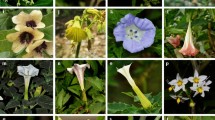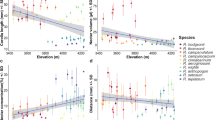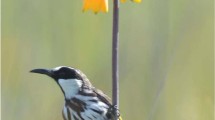Abstract
Pollinators are important agents of selection on floral traits, including nectar sugar composition. Although it is widely assumed that the proportion of sugars (mainly sucrose, glucose and fructose) in nectar reflects pollinators’ physiological limitations and digestive efficiency, the relative impact of pollinators and abiotic factors on nectar sugar composition, as well as the generality of these associations across the angiosperms, remain unknown. We compiled data on nectar sugar composition for >1000 plant species, along with information on flower visitors, plant growth form and latitudinal climatic zone, to provide the first comprehensive assessment of correlates of variation in sugar nectar composition in the angiosperms. After assembling a phylogeny linking all species in the dataset, we estimated the amount of phylogenetic signal in the percentage of sucrose and, by applying phylogenetically-informed multiple regressions, we evaluated whether nectar composition was influenced either by the main pollinator group, plant growth form, or latitudinal climatic zone. The relative importance of each of these factors was then assessed through model selection based on Akaike information criteria and deviance partitioning analysis. Nectar was dominated by sucrose in 56.8% of all the species, glucose in 16.7%, and fructose in 5.5%. Nectar in the remaining species was characterized by similar proportions of the three sugars. Variation in the proportion of sucrose was highest (~70%) at the intrafamily level, and had a significant but low phylogenetic signal, which partially reflects phylogenetic conservatism of the pollinator niche. After controlling for phylogenetic effects, the proportion of sucrose was mainly related to pollinator type and secondarily to climate. Accordingly, this study indicates that nectar sugar composition shows high evolutionary lability and its variation reflects plant-pollinator associations.


Similar content being viewed by others
References
Ackermann M, Weigend M (2006) Nectar, floral morphology and pollination syndrome in Loasaceae subfam. Loasoideae (Cornales). Ann Bot 98:503–514
Baker HG, Baker I (1983) Floral nectar sugar constituents in relation to pollinator type. In: Jones CE, Little RJ (eds) Handbook experimental pollination biology. Scientific and Academic Editions, New York, pp 117–141
Baker HG, Baker I (1990) The predictive value of nectar chemistry to the recognition of pollinator types. Isr J Bot 39:157–166
Beaulieu J, O’Meara B (2016) OUwie: analysis of evolutionary rates in an OU framework. R package version 1.50. https://CRAN.R-project.org/package=OUwie
Beaulieu JM, Jhwueng D-C, Boettiger C, O’Meara BC (2012) Modeling stabilizing selection: expanding the Ornstein–Uhlenbeck model of adaptive evolution. Evolution 66:2369–2383. doi:10.1111/j.1558-5646.2012.01619.x
Blomberg SP, Garland T (2002) Tempo and mode in evolution: phylogenetic inertia, adaptation and comparative methods. J Evol Biol 15:899–910. doi:10.1046/j.1420-9101.2002.00472.x
Blomberg SP, Garland T, Ives AR (2003) Testing for phylogenetic signal in comparative data: behavioral traits are more labile. Evolution 57:717–745. doi:10.1111/j.0014-3820.2003.tb00285.x
Bruneau A (1997) Evolution and homology of bird pollination syndromes in Erythrina (Leguminosae). Am J Bot 84:54–71
Butler MA, King AA (2004) Phylogenetic comparative analysis: a modeling approach for adaptive evolution. Am Nat 164:683–695. doi:10.1086/426002
Canto A, Herrera CM (2012) Micro-organisms behind the pollination scenes: microbial imprint on floral nectar sugar variation in a tropical plant community. Ann Bot 110:1173–1183. doi:10.1093/aob/mcs183
Chalcoff VR, Aizen MA, Galetto L (2006) Nectar concentration and composition of 26 species from the temperate forest of South America. Ann Bot 97:413–421
Díaz S, Cabido M, Casanoves F (1998) Plant functional traits and environmental filters at regional scale. J Veg, Sci, p 9
Drummond A, Rambaut A (2007) BEAST: Bayesian evolutionary analysis by sampling trees. BMC Evol Biol 7:214
Dupont YL, Hansen DM, Rasmussen JT, Olesen JM (2004) Evolutionary changes in nectar sugar composition associated with switches between bird and insect pollination: the Canarian bird-flower element revisited. Funct Ecol 18:670–676. doi:10.1111/j.0269-8463.2004.00891.x
Elisens WJ, Freeman C (1988) Floral nectar sugar composition and pollinator type among new world genera in tribe Antirrhineae (Scrophulariaceae). Am J Bot 75:971–978
Faegri K, van der Pijl L (1979) The principles of pollination ecology. Pergamon Press, New York
Felsenstein J (1985) Phylogenies and the comparative method. Am Nat 125:1–15
Freeman C, Head KC (1990) Temperature and sucrose composition of floral nectars in Ipomopsis longiflora under field conditions. Sowthwest Nat 35:423–426
Freeman C, Worthington RD, Jackson MS (1991) Floral nectar sugar compositions of some south and southeast Asian species. Biotropica 23:568–574
Galetto L, Bernardello G (2003) Sugar nectar composition in Angiosperms from Chaco and Patagonia (Argentina): an animal visitor’s matter. Plant Syst Evol 238:69–86
Gelman A, Hill J (2007) Data analysis using regression and multilevel/hierarchical models. Cambridge University Press, New York
Gómez JM, Perfectti F, Klingenberg CP (2014) The role of pollinator diversity in the evolution of corolla-shape integration in a pollination-generalist plant clade. Philos Trans R Soc Lond B Biol Sci 369:20130257. doi:10.1098/rstb.2013.0257
Gómez JM, Perfectti F, Abdelaziz M et al (2015a) Evolution of pollination niches in a generalist plant clade. New Phytol 205:440–453. doi:10.1111/nph.13016
Gómez JM, Perfectti F, Lorite J (2015b) The role of pollinators in floral diversification in a clade of generalist flowers. Evolution 69:863–878. doi:10.1111/evo.12632
González-Moreno P, Pino J, Carreras D et al (2013) Quantifying the landscape influence on plant invasions in Mediterranean coastal habitats. Landsc Ecol 28:891–903
Grafen A (1989) The phylogenetic regression. Philos Trans R Soc Lond B Biol Sci 326:119–157
Hansen TF (1997) Stabilizing selection and the comparative analysis of adaptation. Evolution 51:1341. doi:10.2307/2411186
Harvey PH, Pagel MD (1991) The comparative method in evolutionary biology. Oxford University Press, Oxford
Heinrich B (1975) Energetics of pollination. Annu Rev Ecol Syst 6:139–170
Ives AR, Midford PE, Garland T (2007) Within-species variation and measurement error in phylogenetic comparative methods. Syst Biol 56:252–270
Johnson SD, Nicolson SW (2008) Evolutionary associations between nectar properties and specificity in bird pollination systems. Biol Lett 4:49–52. doi:10.1098/rsbl.2007.0496
Johnson SD, Pauw A, Midgley J (2001) Rodent pollination in the African lily Massonia depressa (Hyacinthaceae). Am J Bot 88:1768–1773
Kamilar JM, Cooper N (2013) Phylogenetic signal in primate behaviour, ecology and life history. Philos Trans R Soc Lond B Biol Sci 368:20120341. doi:10.1098/rstb.2012.0341
Krömer T, Kessler M, Lohaus G, Schmidt-Lebuhn AN (2008) Nectar sugar composition and concentration in relation to pollination syndromes in Bromeliaceae. Plant Biol 10:502–511. doi:10.1111/j.1438-8677.2008.00058.x
Kuhn TS, Mooers AØ, Thomas GH (2011) A simple polytomy resolver for dated phylogenies. Methods Ecol Evol 2:427–436. doi:10.1111/j.2041-210X.2011.00103.x
Losos JB (2008) Phylogenetic niche conservatism, phylogenetic signal and the relationship between phylogenetic relatedness and ecological similarity among species. Ecol Lett 11:995–1003. doi:10.1111/j.1461-0248.2008.01229.x
Losos J (2011) Seeing the forest for the trees: the limitations of phylogenies in comparative biology. Am Nat 177:709–727
Martén-Rodríguez S, Fenster CB, Agnarsson I et al (2010) Evolutionary breakdown of pollination specialization in a Caribbean plant radiation. New Phytol 188:403–417. doi:10.1111/j.1469-8137.2010.03330.x
Martínez del Rio C, Baker HG, Baker I (1992) Ecological and evolutionary implications of digestive processes: bird preferences and the sugar constituents of floral nectar and fruit pulp. Experientia 48:544–551
Martins EP, Hansen TF (1997) Phylogenies and the comparative method: a general approach to incorporating phylogenetic information into the analysis of interspecific data. Am Nat 149:646–667
McKnight T, Hess D (2000) Climate zones and types: the Köppen system. Prentice Hall, Englewood Cliffs
Nicolson SW (2007) Nectar consumers. In: Nicolson SW, Nepi M, Pacini E (eds) Nectaries and nectar. Springer, Amsterdam, pp 289–342
Nicolson SW, Thornburg RW (2007) Nectar chemistry. In: Nicolson SW, Nepi M, Pacini E (eds) Nectaries and nectar. Springer, Amsterdam, pp 215–264
Oksanen J, Blanchet FG, Kindt R et al (2015) Vegan: community ecology package. R package version 2.2-1
Orme D, Freckleton R, Thomas G et al (2013) Caper: comparative analyses of phylogenetics and evolution in R. https://CRAN.R-project.org/package=caper
Ornelas JF, Ordano M, De-Nova AJ et al (2007) Phylogenetic analysis of interspecific variation in nectar of hummingbird-visited plants. J Evol Biol 20:1904–1917. doi:10.1111/j.1420-9101.2007.01374.x
Pacini E, Nepi M, Vesprini JL (2003) Nectar biodiversity: a short review. Plant Syst Evol 238:7–21
Paiaro V, Oliva GE, Cocucci AA, Sérsic A (2012) Caracterización y variación espacio-temporal del néctar en Anarthrophyllum desideratum Fabaceae): influencia del clima y los polinizadores. Bol Soc Argent Bot 47:375–387
Pérez F, Arroyo MTK, Medel R (2007) Phylogenetic analysis of floral integration in Schizanthus (Solanaceae): does pollination truly integrate corolla traits? J Evol Biol 20:1730–1738. doi:10.1111/j.1420-9101.2007.01393.x
Petanidou T (2005) Sugars in mediterranean floral nectars: an ecological and evolutionary approach. J Chem Ecol 31:1065–1088. doi:10.1007/s10886-005-4248-y
Pinheiro J, Bates D, DebRoy S, Sarkar D (2014) nlme: linear and nonlinear mixed effects models. http://cran.r-project.org/web/packages/nlme/inde
Proctor M, Yeo P, Lack A (1996) The natural history of pollination. HarperCollins Publishers, New York
R Development Core Team (2015) R: a language and environment for statistical computing. R Foundation for Statistical Computing, Vienna
Rebetez M, Reinhard M, Buttler A (2004) Tree physiology. Forests, tree physiology and climate. Encycl For Sci 15:419–426
Revell LJ (2012) phytools: an R package for phylogenetic comparative biology (and other things). Methods Ecol Evol 3:217–223. doi:10.1111/j.2041-210X.2011.00169.x
Revell LJ, Harmon LJ, Collar DC (2008) Phylogenetic signal, evolutionary process, and rate. Syst Biol 57:591–601. doi:10.1080/10635150802302427
Rosas-Guerrero V, Aguilar R, Martén-Rodríguez S et al (2014) A quantitative review of pollination syndromes: do floral traits predict effective pollinators? Ecol Lett 17:388–400. doi:10.1111/ele.12224
Sakai S, Kawakita A, Ooi K, Inoue T (2013) Variation in the strength of association among pollination systems and floral traits: evolutionary changes in the floral traits of Bornean gingers (Zingiberaceae). Am J Bot 100:546–555. doi:10.3732/ajb.1200359
Schmidt-Lebuhn AN, Schwerdtfeger M, Kessler M, Lohaus G (2007) Phylogenetic constraints vs. ecology in the nectar composition of Acanthaceae. Flora 202:62–69
Schondube JE, Martínez del Rio C (2004) Sugar and protein digestion in flowerpiercers and hummingbirds: a comparative test of adaptive convergence. J Comp Physiol B Biochem Syst Environ Physiol 174:263–273
Smith SD, Ané C, Baum DA (2008) The role of pollinator shifts in the floral diversification of Iochroma (Solanaceae). Evolution 62:793–806. doi:10.1111/j.1558-5646.2008.00327.x
Steenhuisen S-L, Johnson SD (2012) Evidence for beetle pollination in the African grassland sugarbushes (Protea: Proteaceae). Plant Syst Evol 298:857–869. doi:10.1007/s00606-012-0589-5
Stiles FG, Freeman C (1993) Patterns in floral nectar characteristics of some bird-visited plant species from Costa Rica. Biotropica 25:191–205
Sturm A, Tang G-Q (1999) The sucrose-cleaving enzymes of plants are crucial for development, growth and carbon partitioning. Trends Plant Sci 4:401–407. doi:10.1016/S1360-1385(99)01470-3
Turner RC, Midgley JJ, Johnson SD (2011) Evidence for rodent pollination in Erica hanekomii (Ericaceae). Bot J Linn Soc 166:163–170. doi:10.1111/j.1095-8339.2011.01139.x
van der Niet T, Johnson SD (2012) Phylogenetic evidence for pollinator-driven diversification of angiosperms. Trends Ecol Evol 27:353–361. doi:10.1016/j.tree.2012.02.002
Van Wyk BE, Nicolson SW (1995) Xylose is a major nectar sugar in Protea and Faurea. S Afr J Sci 91:151–153
Villarreal AG, Freeman C (1990) Effects of temperature and water stress on some floral nectar characteristics in Ipomopsis longiflora (Polemoniaceae) under controlled conditions. Bot Gaz 151:5–9
Warton DI, Hui FK (2011) The arcsine is asinine: the analysis of proportions in ecology. Ecology 92:3–10. doi:10.1890/10-0340.1
Waser NM, Chittka L, Price MV et al (1996) Generalization in pollination systems, and why it matters. Ecology 77:1043–1060. doi:10.2307/2265575
Webb CO, Donoghue MJ (2005) Phylomatic: tree assembly for applied phylogenetics. Mol Ecol Notes 5:181–183. doi:10.1111/j.1471-8286.2004.00829.x
Webb CO, Ackerly DD, Kembel SW (2008) Phylocom: software for the analysis of phylogenetic community structure and trait evolution. Bioinformatics 24:2098–2100
Wester P, Stanway R, Pauw A (2009) Mice pollinate the Pagoda Lily, Whiteheadia bifolia (Hyacinthaceae)—first field observations with photographic documentation of rodent pollination in South Africa. S Afr J Bot 75:713–719. doi:10.1016/j.sajb.2009.07.005
Wiens D (1984) Ovule survivorship, brood size, life history, breeding systems, and reproductive success in plants. Oecologia 64:47–53. doi:10.1007/BF00377542
Wikström N, Savolainen V, Chase MW (2001) Evolution of the angiosperms: calibrating the family tree. Proc Biol Sci 268:2211–2220. doi:10.1098/rspb.2001.1782
Witt T, Jürgens A, Gottsberger G (2013) Nectar sugar composition of European Caryophylloideae (Caryophyllaceae) in relation to flower length, pollination biology and phylogeny. J Evol Biol 26:2244–2259. doi:10.1111/jeb.12224
Wolff D (2006) Nectar sugar composition and volumes of 47 species of gentianales from a southern ecuadorian montane forest. Ann Bot 97:767–777
Acknowledgements
We thank Santiago Benitez-Vieyra, Rachel Dickson, Carolina Morales, Marina Strelin, and Miguel Verdú for their critical reading and for providing suggestions and comments on earlier versions of the manuscript. All authors are Scientific Researchers of the Consejo Nacional de Investigaciones Científicas y Técnicas of Argentina (CONICET). This work was partially supported by the Fondo para la Investigación Científica y Tecnológica (FONCyT, PICT-CHALCOFF-2008-1598).
Author information
Authors and Affiliations
Corresponding author
Electronic supplementary material
Below is the link to the electronic supplementary material.
Rights and permissions
About this article
Cite this article
Chalcoff, V.R., Gleiser, G., Ezcurra, C. et al. Pollinator type and secondarily climate are related to nectar sugar composition across the angiosperms. Evol Ecol 31, 585–602 (2017). https://doi.org/10.1007/s10682-017-9887-2
Received:
Accepted:
Published:
Issue Date:
DOI: https://doi.org/10.1007/s10682-017-9887-2




